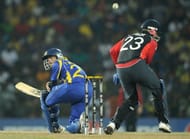
Sri Lanka’s Tillakaratne Dilshan (L) plays a scoop shot over the head of England wicketkeeper Matt Prior (R) during the World Cup 2011 quarter-final at The R. Premadasa Stadium in Colombo on March 26, 2011. As batsmen have got more innovate, as have the bowlers with the slower bouncer and yorker. (Getty Images)
Slower Bouncer:
Till not so long ago a slower bouncer would have seemed like an oxymoron. Bouncers were meant to be short fast deliveries that were directed towards a batsman’s body. It was meant to intimate batsmen, push them to the back foot and get them out either in the slip cordon or at backward short leg.
While all of that remains true even today, bowlers have unearthed a cousin of the erstwhile bouncer, who may not share all the personalities of its older cousin, but proves to be just as effective.
Shaun Pollock is credited for having introduced this variant to the cricketing universe. In subcontinent pitches, a traditional bouncer at times was deemed less effective as the inherent slow nature of the track made it easier for batsmen to pull, hook or cut it for runs.
For a slower bouncer, the ball tends to grip the surface and therefore it becomes difficult for batsmen to predict the speed as well as the exact bounce on offer. As a result it is quite difficult to get them away.
During the death overs of a limited overs match a batsman can get away by swinging wildly at a bouncer and even a top edge can go for a boundary or six. But since there is not much pace on offer in a slower bouncer, a mistimed shot is more likely to fetch a wicket rather than going for runs.
Slower Yorker:
A fast straight/swinging yorker was a fast bowler’s best friend when he desperately needed wickets or dot balls during the business end of an innings. However, first Douglas Marillier and later Tillakaratne Dilshan came up with innovative ramp shots and scoop shots, which started becoming very productive, run scoring options.
Whenever a yorker would be attempted, they would get down on their knees and try to scoop the ball over the wicketkeeper’s head for four by using the pace on offer. That is where the slower yorker proved to be extremely useful.
While it continued to remain low and targeted at the stumps, the lack of pace meant that now the batsmen have to generate all the power. And doing that on a bent knee and that too for a delivery that is on yorker length can prove to be an onerous task in itself.
However a slower yorker’s value is not restricted to the limited overs arena. It can be just as useful in Test cricket as well, as Courtney Walsh exhibited against Graeme Thorpe in the nineties.
Follow IPL Auction 2025 Live Updates, News & Biddings at Sportskeeda. Get the fastest updates on Mega-Auction and cricket news
